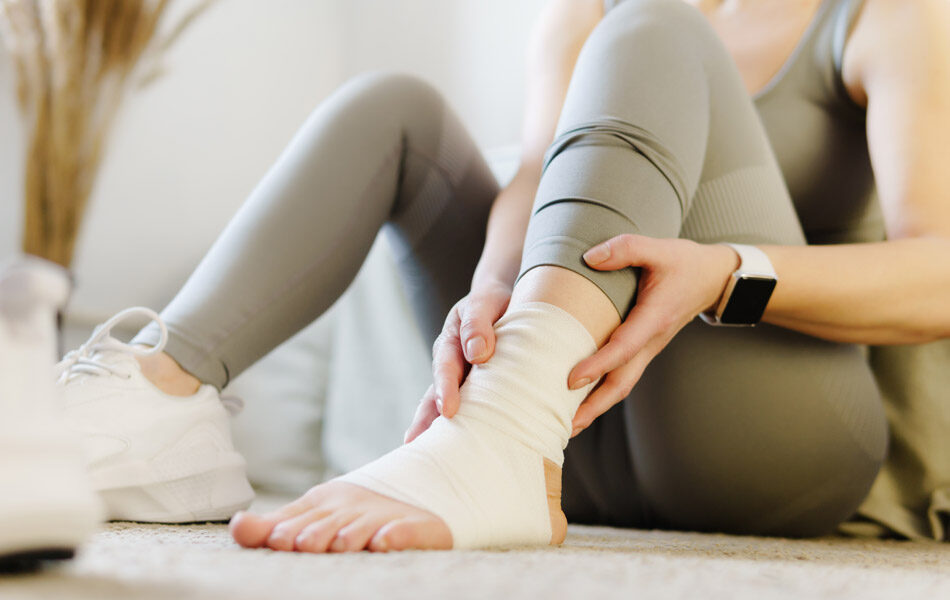Preventing Ankle Pain When Walking: 5 Expert Tips
Ankle pain can limit your mobility and keep you from enjoying your favorite physical activities. Read on if you’re ready to make ankle pain a thing of the past.

Pain-free mobility is something most of us take for granted. Since we’ve been walking for so long, it’s normal not to notice or appreciate how much value it adds to our day.
That is until we can no longer do it comfortably.
Ankle pain is a common problem that can, depending on its severity, keep you from playing sports or make you dread getting out of bed in the morning.
Getting to the root of the problem should be a top priority, and in this article, you’ll learn everything you need to know about the different kinds of ankle pain and how to prevent it.
Why Does My Ankle Hurt When I Walk?
Ankle pain is a common problem and can be caused by various ailments. Regardless of why you’re experiencing ankle pain, getting to the root of the problem should be a top priority.
Any condition that affects your mobility can seriously impact your quality of life, which should be dealt with immediately. Remedying your ankle pain will help you move from point A to point B easily and keep you from having a more serious condition in the future.
#1 Sprains and strains
Ankle sprains are the most common ankle injuries caused by you straining or tearing the ligaments that support your ankle joint. Sprains are injuries that tend to have a ridiculous backstory, like stepping off a curb unexpectedly or rolling your ankle while walking.
Sprains usually heal on their own in a few days, as long as you don’t put unnecessary strain on the sprained ankle.
But in cases where you’re dealing with a completely torn ankle ligament or don’t give a mildly sprained ankle time to rest, you could be left with something called ankle instability.
Ankle instability can lead to chronic lateral ankle pain and contribute to gout or rheumatoid arthritis.
#2 Fractures
Ankle fractures are much more serious than sprains. They can be diagnosed by sudden ankle pain immediately after falling on your foot or twisting or rotating it in the wrong direction while walking or running.
For non-displaced fractures, meaning those where the bone fragments are still in place, a walking boot and time to heal do the trick. More serious fractures usually require a visit to foot and ankle surgeons who can realign the bones before you begin the healing process.
#3 Tendonitis
Tendonitis is another tricky injury resulting from inflamed ankle ligaments and tendons that cause pain and swelling in the region. Tendonitis can be caused by an ankle sprain or general overuse, especially if you play sports or frequently don’t wear proper footwear.
The inflammation caused by tendonitis can lead to ankle pain when walking and stiffness when seated.
Although there are tools you can use to relieve discomfort at the moment, recovering from tendonitis can be tedious. Still, it should be a priority, as long-term tendonitis can lead to more serious ankle injuries.
#4 Bursitis
Bursae are small fluid-filled sacs that surround all the joints in your body and are responsible for cushioning and lubricating your joints to prevent friction and make your movements more comfortable.
If one of the three bursae that surround your heel bone becomes inflamed, either through repetitive physical activity or a flare-up of pre-existing medical conditions, it can cause foot and ankle pain when walking or flexing your feet.
Plenty of rest and wearing supportive footwear will be essential for you to relieve pain and reduce the swelling that causes bursitis.
#5 Flatfeet
Flatfeet is a condition where the foot has little or no arch, resulting in the entire sole of the foot touching the floor when standing.
This is a common condition that some people are born with, and others develop it further in life due to regular wear and tear. For many people, having flatfeet doesn’t cause foot or ankle pain. Others will experience ankle pain mostly in the heel and arch area.
A great technique for treating and preventing ankle instability and pain is to strengthen the muscles and tendons surrounding your ankle.
Working with a physical therapist can help. But so can using a walking app like Walking.Diet that offers personalized walking programs that can be catered to injuries and help you rebuild strength slowly and sustainably – a must for anyone rehabbing ankle injuries.

- Offers walking training plan
- Provides warm-up and cool-down workouts before and after walking workout
- Includes keto desserts cookbook
- Offers the articles about food and nutrition, walking gear
5 Ways to Reduce Ankle Pain
Ready to make your ankle pain a thing of the past? These are proven methods recommended by physical therapists that can put you on a path toward healing your ankle pain and preventing it from coming back in the future.
#1 RICE
RICE stands for rest, ice, compression, and elevation. This method is designed to help you reduce swelling and is ideal for treating sprains, tendonitis, and bursitis since all three are caused by inflammation.
#2 Massages
Getting a deep tissue massage on your feet and calves is an effective way to stimulate blood flow to this area of the body, helping to reduce ankle pain and expedite the healing process.
During your massage, your therapist might also use gentle stretches to increase the flexibility of the muscles and ligaments surrounding your ankle. Increasing flexibility can alleviate ankle pain and help you maintain a full range of motion throughout your healing process.
#3 Tapes and bandages
Trying to repair torn ligaments isn’t easy since they can easily be stretched and strained again while you walk, causing you to have to start the healing process over from square one.
If you’re dealing with ankle instability due to an ankle sprain, using tape or an elastic bandage can help support your ankle while it’s healing. Taping is a more effective treatment than using an ankle brace because it also provides compression to manage inflammation.
#4 Supportive footwear
One of the easiest ways to prevent ankle pain when walking is to invest in footwear with a nice cushion sole and plenty of arch support and to upgrade your shoes when your old running shoes are worn out.
A pair of shoes with ample arch support can naturally prevent flat-footedness and the ankle soreness it can cause. At the same time, shoes with a thick, cushiony sole can protect your ankle joints by reducing the amount of impact that you experience while walking and running.
#5 Medications and supplements
If you’ve been dealing with pain in your ankle bones or joints, there’s a good chance you’ve been prescribed over-the-counter pain medication to lessen your symptoms.
More serious conditions, like gout or rheumatoid arthritis, may require therapies that use a combination of painkillers and steroids to relieve pain.
There are also steroid injections, which are delivered by a doctor straight into the joint. Cortisone shots have proven useful in reducing swelling and providing pain relief.
A Word From Our Coach
It’s easy to be convinced to take a break from your regular physical activity when you’re experiencing intense pain. Healing from a broken ankle is, in some ways, easier than tendonitis, even though it’s a more serious injury because the healing process is taken more seriously.
You won’t be trying to sneak in a run when you have a cast on your foot, but you might be tempted if all you have is a doctor’s order to take it easy.
The ongoing pain from an injury like tendonitis or a sprain is your body telling you that it needs a break from physical activity. The sooner you listen, the sooner you’ll be back to 100% and ready to comfortably walk 10,000 steps a day.
Conclusion
If your ankles hurt after walking, it could be a sign of a more serious problem. Although ankle pain is common, that doesn’t mean it’s something you should live with.
Physical therapy and some of the home remedies mentioned in this article, like taping your ankles and investing in proper footwear, can offer you the repair you need to live pain-free.

- Offers walking training plan
- Provides warm-up and cool-down workouts before and after walking workout
- Includes keto desserts cookbook
- Offers the articles about food and nutrition, walking gear

















































 Select your language:
Select your language: 








